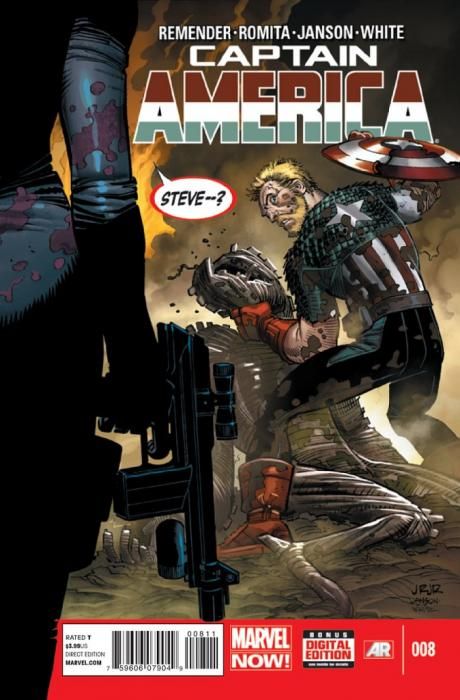The cover for "Captain America" #8 provides a clue to one of the larger moments in this issue, but getting to that moment is a journey Rick Remender lines with broken glass, sharp sticks and rusty nails. There's also an army of mutates, a conflicted heir to the Zola Empire, a knockoff of Captain America's shield cross-bred with a circular saw blade and internal monologue used to stave off certain, creeping death.
Trapped in Dimension Z, with his adopted son Ian turned against him, Cap struggles for reason to continue his fight. Locked in combat with Ian's champion, Captain Zolandia, Steve Rogers fights for his son, hoping to peel the scales from Ian's eyes, undo the brainwashing in the child's mind or whatever needs to be done to return things to normal. Unfortunately, "normal" in Dimension Z is hostile and brutal. Remender fills this issue with the hopelessness and abandon of a final stand: Cap will either save the day and Ian will stand by his side once more or Cap will simply cease. Ian pounds on Cap's fractured confidence while Captain Zolandia hits Rogers' body. Remender writes what all readers expect from Cap: he gets up and keeps fighting.
Romita's art is still rough for me, but fits the setting of Dimension Z. Just as his work was well-matched to the Typhoid Mary tale back in "Daredevil" in the 1980s, it fits Remender's scary, ominous Dimension Z. Romita owns the mutates and the Phrox. He brings just enough Kirbyesque bizarreness to this comic to push the visuals over the top, but he doesn't redefine Captain America to be his own. Romita Jr. is going to be another creator credited with working on Cap, but his stuff won't be the most fondly remembered art for the Sentinel of Liberty. Romita provides solid storytelling, but with jangled anatomy and hideously huge-noggined kids. His depiction of Ian is more in line with the type of child one might expect to see in a comic strip like "Calvin & Hobbes" or "Peanuts," but there is no mistaking Ian's youth. Dean White's forceful colors also fit Dimension Z and mesh nicely with Romita's art. The colorist and artist employ a nice effect of Cap swinging his shield that could only succeed in comics and not every art team could execute that feat.
While "Captain America" #8 is the first time I've checked back in with Steve Rogers in a couple months, the certain-to-be-controversial cliffhanger ending and "Oh, crap!" moments Remender constructs around it make me want to check in again very soon. Remender definitely has a direction and story he hopes to tell and has figured out exactly how to play to his art team's strengths. This might not be the most memorable Captain America tale I've ever read, but it certainly isn't the most predictable.

